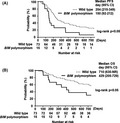- Record: found
- Abstract: found
- Article: found
Clinical significance of BIM deletion polymorphism in chemoradiotherapy for non‐small cell lung cancer

Read this article at
Abstract
The standard treatment for locally advanced non‐small cell lung cancer (NSCLC) is chemoradiotherapy (CRT) followed by anti‐programmed cell death‐ligand 1 (anti‐PD‐L1) treatment. BIM deletion polymorphism induces the suppression of apoptosis resulting from epidermal growth factor (EGFR)‐tyrosine kinase inhibitors in EGFR‐mutated NSCLC patients. We aimed to examine the effects of BIM polymorphism on CRT and anti‐PD‐L1/PD‐1 treatment in NSCLC patients. In this retrospective study of 1312 patients with unresectable NSCLC treated at Higashi‐Hiroshima Medical Center and Hiroshima University Hospital between April 1994 and October 2019, we enrolled those who underwent CRT or chemotherapy using carboplatin + paclitaxel or cisplatin + vinorelbine, or anti‐PD‐L1/PD‐1 treatment. Of 1312 patients, 88, 80, and 74 underwent CRT, chemotherapy, and anti‐PD‐L1/PD‐1 treatment, respectively, and 17.0%, 15.2% and 17.6% of these patients showed BIM polymorphism. Among patients receiving CRT, the progression‐free survival was significantly shorter in those with BIM deletion than in those without. In the multivariate analyses, BIM polymorphism was an independent factor of poor anti‐tumor effects. These results were not observed in the chemotherapy and anti‐PD‐L1/PD‐1 treatment groups. In in vitro experiments, BIM expression suppression using small interfering RNA in NSCLC cell lines showed a significantly suppressed anti‐tumor effect and apoptosis after irradiation but not chemotherapy. In conclusion, we showed that BIM polymorphism was a poor‐predictive factor for anti‐tumor effects in NSCLC patients who underwent CRT, specifically radiotherapy. In the implementation of CRT in patients with BIM polymorphism, we should consider subsequent treatment, keeping in mind that CRT may be insufficient.
Abstract
We showed that progression‐free survival and overall survival durations were significantly shorter in the CRT‐treated NSCLC patients with BIM polymorphism than in those without. Our findings indicate that BIM polymorphism is associated with the efficacy of radiotherapy but not chemotherapy in patients with CRT.
Related collections
Most cited references31
- Record: found
- Abstract: found
- Article: not found
Cancer statistics, 2019
- Record: found
- Abstract: found
- Article: not found
Durvalumab after Chemoradiotherapy in Stage III Non-Small-Cell Lung Cancer.
- Record: found
- Abstract: found
- Article: not found
